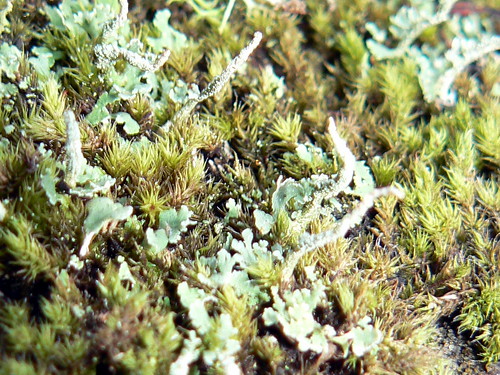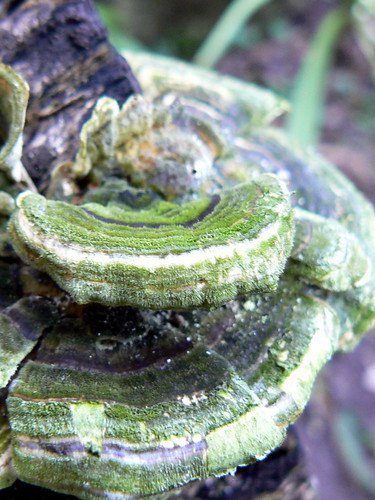Now the wood is decaying and the fungi are clearly pleased with what they can digest from it. I just took these images of the residents.
This is a jelly fungus, Tremella spp. It feels just as you'd expect: soft and gelatinous. Tremella are parasitic on other fungi and in this case, it's possible it's feeding on the hyphae of the next fungus:
A bracket (or shelf) fungus. I'm unsure of the species, but suspect that the green colouring might be a lichen growing on the fungus itself. Lichen is the result of a mutualistic relationship between an algae and a fungus, so if this is lichen, it's an example of two symbioses: one parasitic, one mutualistic. If anyone reading can identify the fungi and confirm if it's wearing a very fetching lichen jacket, please, let me know!
Busy place, the stump.
And on the sandstone rock next to it, another thriving ecosystem is growing:

Here are moss and what I'm pretty sure are hornworts, which comprise the pale green flattened lobes and horn-like capsules in which the spores are produced.


Very pretty. I'm afraid I'm not terribly familiar with lichen, Margaret, but the bracket fungi sure looks furry.
ReplyDeleteIndeed it does, Julian. I wish now I'd taken a photo of it before. I'm pretty sure it was orange....
ReplyDeleteI find it interesting how when I look at some of the pictures on your site, it's crystal-clear that we live on opposite sides of the planet. No colorful parrots in the trees here in the Pacific NW of the USA, or giant prehistoric-looking flower-things. But the pictures of fungus and moss could have been taken in my backyard. Many of the animals and plants in your garden look incredibly alien and exotic to me eye; I wonder what things I see every day would seem strange to you?
ReplyDeleteHi Bill,
ReplyDeleteI guess that the things that look familiar are often those which evolved before our land masses separated. There probably hasn't been much change in mosses, while all sorts of odd things have popped up in (relatively!) recent times. Interestingly, there's quite a bit of variation between plant species of south east and south west Australia. They were divided and speciated not by the separation of land masses, but by the desertification of the region between them. So cool the way history is written into biodiversity, isn't it?
No doubt you've got lots of local mammals that would have me boggled: raccoons, opossums, buffalo, squirrels, skunks, bears...? Most of these I've only seen in zoos--and American cartoon series!